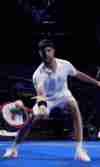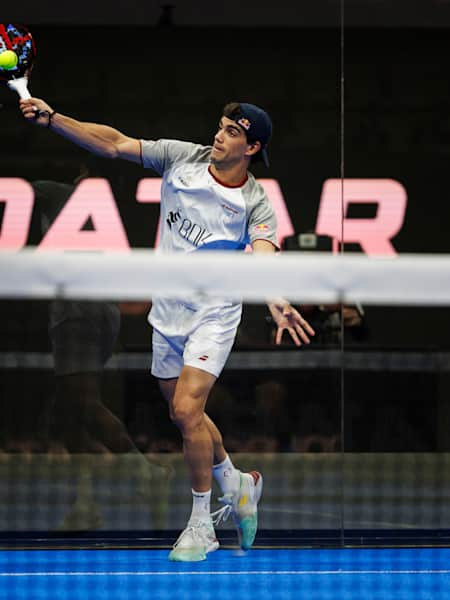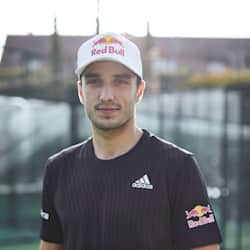If you're a fan of racket sports, surely at some point you have held a padel racket. Padel has burst into the sports world, especially at the amateur level. Being a very accessible and easy sport to practice, perfect to 'get ready,' padel is truly making an impact on society. The number of players and padel courts has multiplied in a few years. To practice it, all you need is a court, a padel racket, a ball, three other people, and some good shoes. Here are some facts about the history and development of padel...
01
Where does the name 'padel' come from?
The name 'padel' comes from the English word 'paddle,' which means 'shovel' or 'racket,' a term that became part of the Spanish language after it was included in the Dictionary of the Spanish Language (RAE).
- Padel. From English 'paddle tennis.'
- Graphic adaptation proposed for the English word padel (tennis), 'sport similar to tennis played with wooden rackets': "Common areas with gardens, swimming pools and padel courts" (Mundo [Esp.] 23.3.01) // Game between two couples, very similar to tennis, but played between four walls and in which the ball is hit with a short-handled padel.
02
The birth of padel
The roots of padel can be traced back to earlier racket sports, like platform tennis, which originated in the United States during the 1920s. Platform tennis was played on raised platforms, typically during the winter, and featured heating elements below the deck to melt snow. Similar to padel, it used solid paddles and a surrounding net, but differed significantly in terms of court size and the use of a spongy, rubber ball. These elements may have inspired the basic structure and dynamics of padel, albeit adapted to different climates and settings.
Padel’s actual beginnings date back to 1969 and Mexican businessman Enrique Corcuera, an avid tennis fan. Corcuera, on one of his trips to the United States, had tried 'paddle-tennis', a game inspired by tennis, but played on a smaller court, with a lower net and replacing the racket with a paddle. Based on that concept, Corcuera adapted a piece of land he owned in Las Brisas, Acapulco, Mexico, installing a small court 20m long by 10m wide, to which he added walls on the sides, with the idea of preventing vegetation from invading the court and the balls from getting into the neighbor's property. Squash, another influential racket sport, likely influenced Corcuera's initial court design with its enclosed playing area and wall play, aligning closely with the padel format that encourages longer rallies and strategic use of the enclosure.
Bouncing off the walls made [padel] more fun and fluid.
"They tried different balls, observing that the best one turned out to be the tennis ball. Bouncing off the walls made it more fun and fluid," explains Omar Villavicencio, president of the Mexican padel Federation [FEMEXPADEL].
No one could have imagined back then that this improvised idea would give rise to a new sport that would eventually spread around the world.
03
Expansion to Spain
The export of padel to Spain also had to do with Enrique Corcuera, who, during the summer, invited his aristocratic friends to play with him on his court at Las Brisas. The passage of his friend Prince Alfonso de Hohenlohe-Langenburg, real estate developer and founder of the Marbella Club, was key in this expansion. He was responsible for taking it to Spain and introducing it to the Costa del Sol in 1974, building two courts in his hotel-club. These two courts were the first ones built in Spain and, unlike the one at Corcuera's house, instead of side walls, they had a wire fence.
Between 1980 and 1990, The Marbella Club courts hosted the famous 'Pro-Am' tournaments, sponsored by the Smith & Smith stores in Las Arenas (Vizcaya), owned by the man who would become the first president of the International Padel Federation in 1991, Julio Alegría Artiach, one of the most important people in the history of the sport, who established the rules of padel at an international level.
The key moment in the evolution of padel in Spain was the 1990s, when prominent figures from the political, business, and journalistic spheres took up padel, which led to it becoming a trending sport. The rapid success of padel attracted prominent tennis figures such as Manolo Santana. The Spanish champion began to practice it frequently and started to organize tournaments on the Costa del Sol, becoming one of the major promoters of padel in Spain, where several clubs began to build their own courts.
04
Worldwide export and international recognition
After witnessing its success first hand, in 1975, Julio Menditeguy, an Argentine friend of Alfonso de Hohenlohe, decided to import this new sport to his country. In Argentina, padel gained unprecedented importance, becoming the second most practiced sport.
Names such as Horacio Álvarez Clementi, Cacho Nicastro, and Diógenes de Urquiza, national pioneers, contributed greatly to this exponential development. Additionally, many Argentine polo players who travelled to Spain discovered padel in Marbella and, upon returning to Argentina, became natural ambassadors of this 'new easy and fun game with cheap facilities'.
In 1988, with Oscar 'Cacho' Nicastro at the helm, the Argentine Paddle Association (APA) was founded. Nicastro, who became the president of the Association, looking to give an international boost to the game, reached an agreement to organize the first matches between Spain and Argentina, giving rise to another of the great moments in the history of international padel.
In addition to Argentina, padel quickly spread to other countries in the American continent, such as Brazil, Uruguay, Chile, and Paraguay. Likewise, its extension in Europe is a fact in countries such as Sweden, Italy, United Kingdom, France or Germany, countries in which federations have been emerging, achieving great success in terms of the number of members and construction of facilities. Spain, in this sense, is recognized as the driving force behind padel in Europe.
In 1993, padel was consolidated as a sport, after its official recognition by the Spanish Superior Council of Sports [CSD - Consejo Superior de Deportes]. One year later, the constitution of the Spanish Padel Association was approved and recorded in the Registry of Sports Associations of the CSD.
05
Evolution of the game
Over the years, padel has undergone several rule changes that have shaped its modern playing style. One significant rule change was the introduction of the underhand serve, mandated to reduce serve dominance and enhance rally length, making the game more about skillful play than power. Additionally, rules regarding wall play were refined, allowing balls to be played off the court, with players going out through the court’s doors, which added a unique tactical layer absent in similar racket sports. This adaptation has led to a more engaging and strategically complex game, attracting a broader audience.
Players are allowed to go out of the court and continue playing the point
© Premier Padel/Red Bull Content Pool
Equipment development
Initially, padel rackets were simple wooden paddles, similar to those used in platform tennis. Over time, these evolved into more sophisticated designs incorporating advanced materials such as carbon fibre and fiberglass, which offer better durability, power, and control. The balls, originally adapted from tennis, have also been refined specifically for padel to balance bounce and speed, enhancing playability. Today, high-performance gear is tailored to player styles and levels, significantly impacting the sport's accessibility and appeal.
06
The greatest padel players in history
Padel has witnessed some legendary rivalries that have not only heightened the sport's drama but also showcased its competitive spirit. As the sport’s main enhancers, both Spain and Argentina have produced the best athletes in padel history. Numbers wise, the most decorated player in the history of padel is, undoubtedly, Argentinian Fernando Belasteguín, who has won more than 200 trophies in his professional career, 165 of which forming an iconic team with Juan Martín Díaz, another legend of this sport.
Together, Belasteguín and Díaz stayed at the top of the world rankings for 13 consecutive seasons. They found their main rivals in Pablo Lima and Juani Mieres, one of the only teams able to beat 'Bela' and Díaz during their historic run.
Even though they didn’t achieve the unimaginable level of greatness that 'Bela' did, other padel icons worth mentioning are Paquito Navarro - known for his raw talent and showman attributes - Sanyo Gutiérrez, and Maxi Sánchez.
While Belasteguín, Díaz, Mieres, and Lima excelled a few years ago, when strategy determined the way padel was played, a new generation of remarkably fast and explosive athletes is taking over by displaying a faster, more dynamic style of play that certainly keeps strategy in mind, but rewards hard-hitting and high-flying teams that add extra speed and power to their shots and moves on the court.
Juan Lebrón and Alejandro Galán can be credited with initiating this new era of faster padel. Lebrón and Galán’s partnership on the court has been particularly impactful, earning them 33 trophies and the top position in the ranking for four consecutive seasons with a high-octane style of play, underlining the evolution of modern padel that is likely to be continued by Agustín Tapia and Arturo Coello, currently the dominating team in the men’s circuit.
Icons in women's padel
Women have played a significant role in the growth of padel, with their participation contributing greatly to the sport's expansion. Female players have not only increased in numbers but have also risen to prominence in international competitions.
Carolina Navarro has been a pivotal figure in women’s padel. Known for her aggressive playing style and strategic acumen, Navarro is the most decorated player in history, having won 100 trophies over the course of her career. Navarro was the top-ranked player for nine consecutive seasons, and a three-time world champion. Her example inspired countless women to take up the sport and led the way for many girls who would become the sport’s current stars.
Alejandra Salazar is certainly one of those athletes. She has won more than 50 titles at the highest level, and climbed to the top of the world ranking four times. Other remarkable women’s padel figures worth mentioning are Icíar Montes (number one in the world for eight years), the Sánchez-Alayeto twins (nicknamed 'The Atomic Twins', ranked first in the world for four years), and Gemma Triay.
Much like the men’s competition, the professional female padel scene is dominated by highly physical and explosive players like Bea González, Martita Ortega, Ariana Sánchez, and Paulita Josemaría (the latter two currently form the top-ranked team in the world). Their success has inspired a new generation of female players, promoting equality in the sport, and highlighting the inclusive nature of padel, which appeals to all ages and skill levels.
07
Padel's remarkable growth
Padel fever in Europe!
Following its introduction and booming popularity in Spain, padel began to spread across Europe. Countries like France, Sweden, and especially Italy, are witnessing padel’s skyrocketing growth firsthand. France has rapidly expanded its number of courts and players, particularly appreciating padel's social aspect and accessibility. Sweden, on the other hand, has developed a strong female scene, with numerous clubs and leagues that cater specifically to women, bolstering female participation and visibility in the sport.
Padel expands its boundaries
Padel has also seen surprising surges in popularity in regions outside its traditional European stronghold. In the Middle East, countries like the United Arab Emirates, Saudi Arabia, and Qatar have embraced padel, building luxury padel facilities as part of larger sports and leisure developments. In Asia, countries such as Japan and the Philippines are beginning to incorporate padel into their sports cultures, drawn by its simplicity and the minimal space requirements compared to traditional tennis.
Where to Watch Premier Padel, the best competition in the world

26 min
Highlights – Qatar Major
Enjoy highlights of the second Premier Padel stop of the season in Doha, the Qatar Major.
To watch padel at its highest level, you can follow the development of the elite professional circuit of this sport, the Premier Padel, which is broadcast by Red Bull TV. With live broadcasts at each of the circuit’s 25 stops, you can watch all the matches of each tournament from the quarter-finals onwards.
Part of this story









